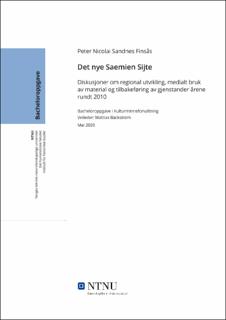| dc.description.abstract | Alle tre problemstillingene blir kort referert, med mulige svar på problemstillingene. Problemstillingene er:
1. Hvordan ble material brukt som medium i samisk institusjonsarkitektur i Norge, samt i nybyggingsplanen for Saemien Sijte 2008–2011?
2. Hvordan beskrev SINTEF det nye Saemien Sijte som en regional utviklingsmotor?
3. Hvordan diskuterte aktører i Bååstede-prosjektet og Saemien Sijte tilbakeføring av gjenstander?
Problemstilling 1. handler om material som medium. I denne oppgaven har material som medium blitt presentert med eksempler på ulike samiske institusjoner. Institusjonene hadde konstruert bygninger med ulike materialer. Disse materialene var både samiske tradisjonelle materialer/råvarer og nye materialer som ikke før blitt brukt i samiske bygninger. For å legitimere materialbruken, måtte materialet ha en form for kulturell relevans.
Et eksempel på material som var ny og som ble brukt i samiske bygninger var betong. Betongen fikk kulturell relevans ved å bruke råvarer/komponenter fra området hvor bygge skulle stå. Dette skapte et forhold mellom landskapet og folket som bodde der.
I nybyggingsplanen for Saemien Sijte 2008–2011, ble ulike materialer kandidater. På grunn av finansieringsproblemer, ble ikke materialet for bygget valgt. Unntaket var materialet glass, eksempelvis i vinduer. De andre materialkandidater var tre, bronse, kobber og cortenstål. I oppgaven ble tre, bronse og kobber definert som materialer med samisk kulturrelevans. Disse tilhørte de tradisjonelle materialene i samisk kultur. Cortenstål var derimot ny. På grunn av endringer på selve prosjektet ble det ingen materialkandidater valgt.
Problemstilling 2. handler om nye Saemien Sijte som regional utviklingsmotor. I en rapport som SINTEF lagde, ble nye Saemien Sijte som en regional utviklingsmotor beskrevet. Ved etableringen av nye Saemien Sijte skulle bygget være en utviklingsfaktor. Denne faktoren skulle skape utviklingspotensial for næringsliv, reise/turisme, arkitektur, arbeidsmuligheter og tilbake-/innflytning av populasjoner. Bygget skulle være som et «fyrtårn», et signalbygg for regionen.
Problemstilling 3. handler om tilbakeføringsprosjektet Bååstede. Prosjektet endte i en avtale der Norsk Folkemuseum og Kulturhistorisk museum skrev under på å gi halvparten av de samiske samlingene deres, til Sametingets museer. Det ble diskutert frem at gjenstandene skulle bli overført juridisk til museene. Saemien Sijte er et av museene, og de kommer å få 163 gjenstander. Det var halvparten av Norsk Folkemuseum og Kulturhistorisk museums sørsamiske samlinger. Grunnen til at Saemien Sijte ikke har fått gjenstandene enda, er at museet ikke har kapasitet til å ta imot dem. Når det nye bygget til Saemien Sijte blir ferdig, kan de ta imot gjenstandene. | |
| dc.description.abstract | In this summary, the research question, the main goal of the article, clarification of concepts and the conclusion will be presented. The research questions are: How was material used as a medium in Sami institution architecture in Norway, as well as in Saemien Sijte’s new construction plan in 2008-2011? How did SINTEF describe the new Saemien Sijte as a regional development engine? “How did persons in the Bååstede-project and Saemien Sijte discuss repatriation of objects?
The main goal
This article revolves around Saemien Sijte in the years surrounding 2010. Three important discussions are addressed, about the Southern Sami museum and culture center. Hence, the main goals are parted into three sections. First, I give an overview of the material as a medium in Sami institutionary architecture and analyze Samien Sijte’s construction plan in 2008-2011. Then, I analyze how the new Samien Sijte was estimated as being a regional development engine in the beginning of the 2010’s. Finally, I give an overview of the repatriation-project Bååstede in Norway, as well as describing Samien Sijte’s relation to the repatriation project in the early 2010’s.
Clarification of concepts
Some terms need clarification in order to better understand this bachelor thesis. These terms are “Sami institution architecture”, “material as medium”, “Bååstede” and “regional development engine”.
Architecture in Sami institutions is a common way of creating architectural expression. There are different architects that build the buildings for the institutions, and many of them use “Sami characteristics” from the history of built environment. In doing so, they argue that the buildings have a cultural relevance.
Material as medium is a term that has been used when talking about Sami buildings. The material use should, as well as with the architecture, have a cultural relevance, which means that the materials and forms should be a part of the materials that has a cultural connection.
Bååstede is a repatriation project where museum objects are given back to the source communities. In this case, it is objects from national museums in Oslo being returned to the Sami people, that is, to Sami museums with collection management. Bååstede means “return” in the Southern Sami language.
Regional development engine is the idea that, for example, a building with remarkable architectural value and attractive activities can develop a region or nation positively. It can be about developing the region’s or the nation’s business, jobs, infrastructure, tourism, population and/or architecture. SINTEF has analyzed the new Saemien Sijte, that is, the plan for the new building 2008-2011, as a possible regional development engine. Based on this analysis, an example of the new Saemien Sijte as a regional development engine may look like this: If the new building for Saemien Sijte is built as an attractive visitor destination, there will be more visitors, thus more jobs, and this can lead to more people moving to region. Because of this, the new Saemien Sijte would be like a “lighthouse”, a signal of the region. | |
